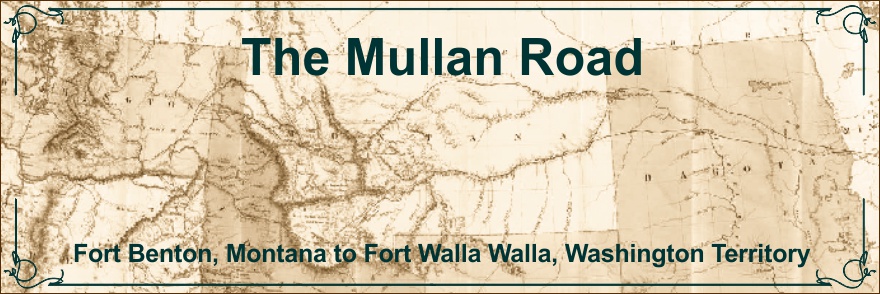
Welcome to the Eastern
Terminus of the Mullan Road
| Originating in Fort Benton,
Montana, The Mullan Road was the first wagon road to
cross the Rocky Mountains to the Inland of the
Pacific Northwest. It was built by US Army Lieut.
John Mullan between the spring of 1859 and summer
1860. It led from Fort Benton, Montana, the
navigational head of the Missouri River (and once
farthest inland port in the world) to Fort Walla
Walla, Washington Territory, near the Columbia
River. The road approximately followed the path of
modern-day Interstate 15 and Interstate 90 through
what is now the states of Montana, Idaho and Washington. |
Route of the Mullan Road
| From the origin at Fort
Benton, Montana, the Mullan Road proceeded: West
from Fort Benton, Montana Passing North of Great
Falls, Montana Dropping south to cross the
continental divide west of Helena, Montana
(following a path through Mullan Pass, immediately
north of that now traveled by U.S. Route 12) Along
the Clark Fork River, near the ghost town of
Bearmouth, Montana Just west of Garrison, Montana,
it joined the route of present-day Interstate 90
(similar to the U.S. Route 12 transition to join
Interstate 90 today) It remained with the Interstate
90 route as it passed Missoula proceeding west
through Montana. The Mullan Road through the
Missoula Valley fostered rapid growth for the
burgeoning city, and allowed the U.S. Army to
establish Fort Missoula there in 1877. The road then
crossed |
|

|
the
border into Idaho near Mullan, Idaho (followed by the later
Interstate 90). The highest elevation of the road is a
second Mullan Pass at 5168 feet (1575 m), which lies about 7
miles (10 km) east of Mullan, Idaho on the Idaho-Montana
border. From the middle of the Idaho crossing, the road
deviates from present-day major roads. The Mullan Road
went southwesterly in Idaho to pass south of Lake Coeur d'Alene
The road then passed into Washington some distance south of
Spokane, Washington From there, the Mullan Road passed
through the Palouse country and then the scablands of
eastern Washington. It passed through Benge, Washington. The
Benge section of the road was completed May 22, 1861; the
wagon ruts were still visible in 2008 just northeast of town
at the site of the First Benge School. South of Benge, there
is a stretch of the former road still labeled 'Mullan Road'.
This gravel section of the Mullan Road travels southwesterly
until it meets Washington State Route 26 near Washtucna,
Washington. The portion of Mullan Road south of SR 26 in
Washington, which follows the course of the Palouse River as
it descends to the Snake River, has been reverted to grazing
and is not accessible to the public. After crossing the
Snake River near the confluence with the Palouse River, the
Mullan Road continues south to its terminus at Fort Walla
Walla near Walla Walla, Washington.
*
Mullan Road: On Line Resources * Additional
information on the Mullan Road available at this
link. |
|

